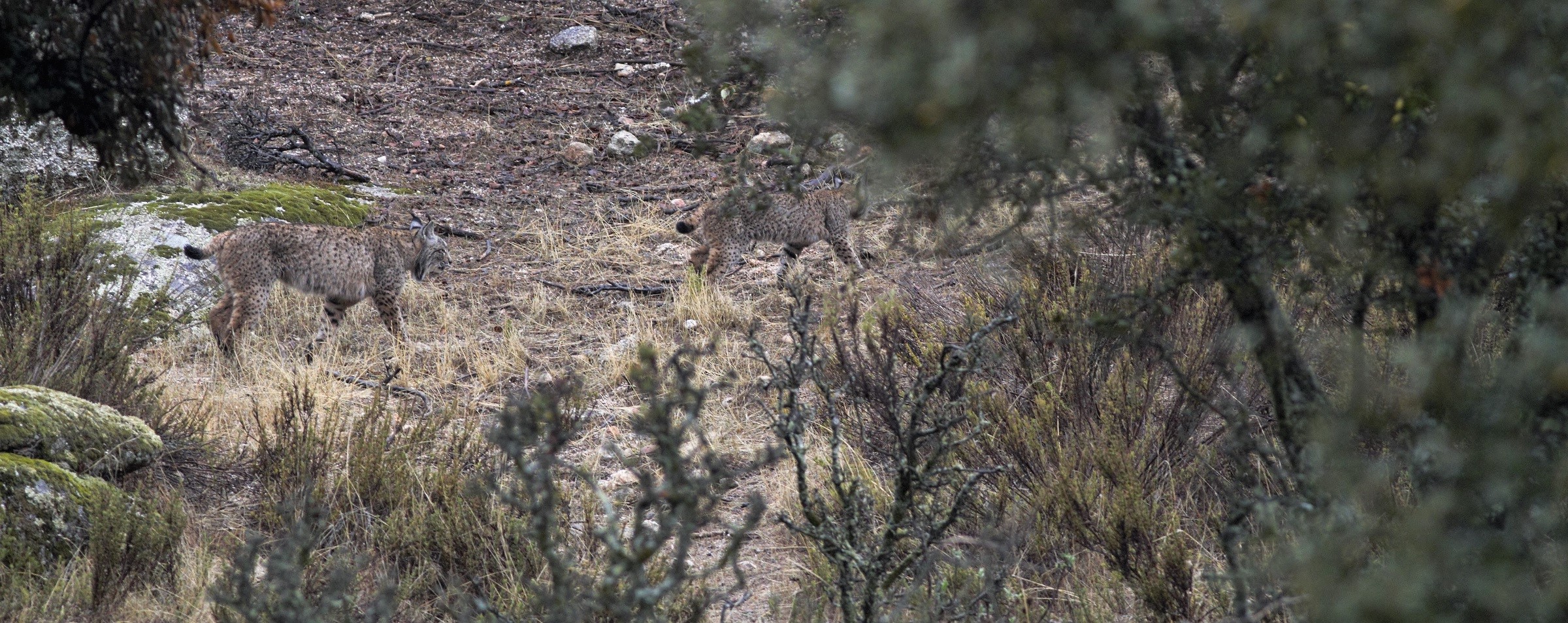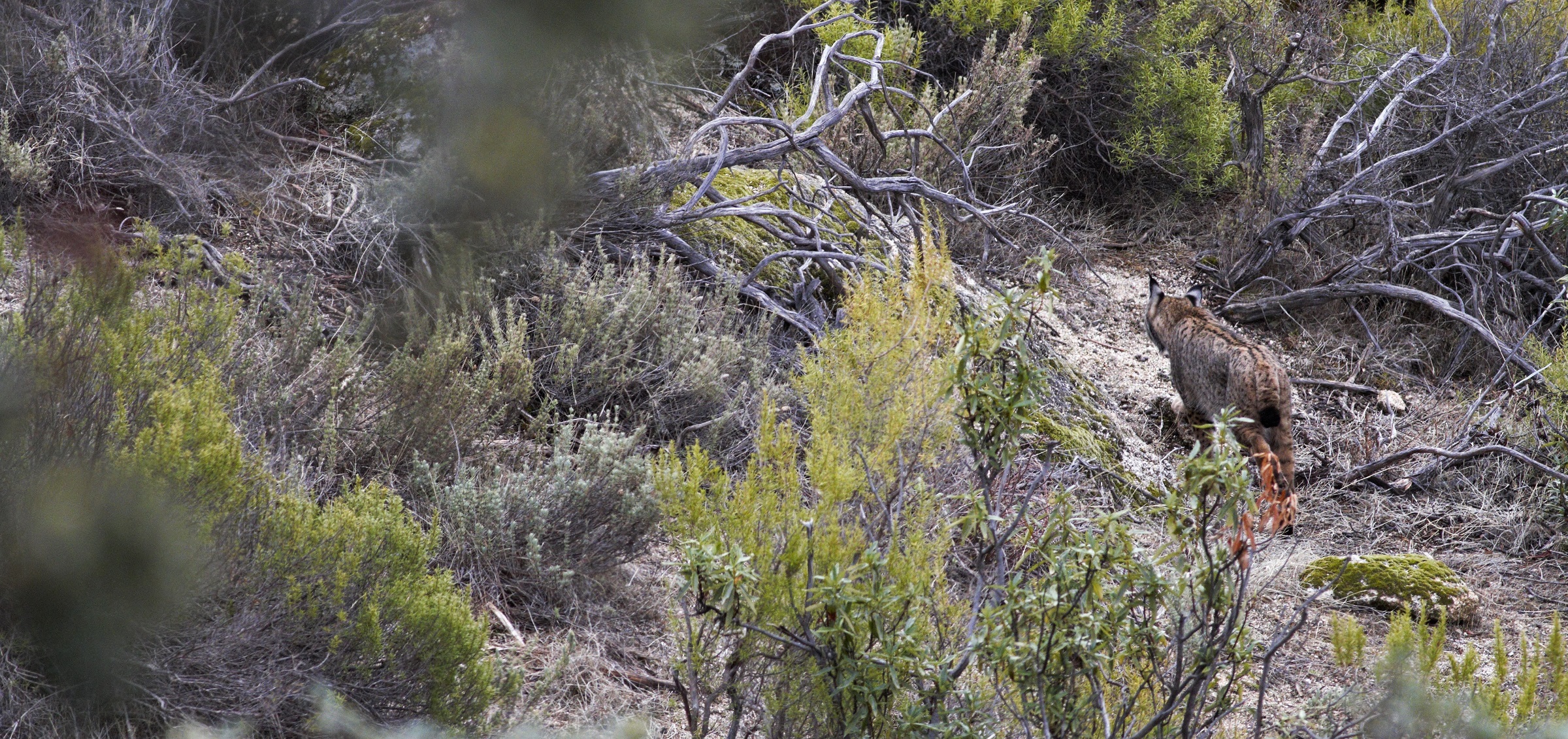Lovely Spain – part two
Sierra Andujar: a lynx heaven on earth
As described in detail before, the Andujar Mountains, part of the Sierra Morens National Park, are also an area where we look for lynx every year; one of our EB5 core animals around which the majority of our European travels are built. Every year the situation of this endangered cat species gets better and better. From fewer than 100 individuals in the wild about 15 years ago, the total population of Iberian Lynx now numbers around 1000 individuals. It should be noted that all types of animals are included in this total number: the remaining wild animals from the beginning, the reintroduced animals and their progeny as well as the animals in specially constructed breeding enclosures – part of the breeding program related to the reintroductions.
- Female Iberian Lynx with kitten © Jan Kelchtermans
Increasing ecotourism
The Andujar area has also undergone a complete evolution over the years in terms of ecotourism. In recent years, the various natural vantage points of the past have been transformed into artificial, landscaped wooden structures with a roof. Fortunately, picnic tables have been omitted. Otherwise you will soon have local people visiting the locations for an extensive lunch or barbecue making noise, litter etc.
- Greater Mouse-eared Bat © Jan Kelchtermans
- Abandoned houses are not exceptional in Spain © Jan Kelchtermans
- Little Owl © Jan Kelchtermans
- Eagle Owl near a boulder where we ‘normally’ see Iberian Lynx © Jan Kelchtermans
- Daubentons Bat (subspecies nathalinae) © Jan Kelchtermans
- Dusk at Sierra Morena © Jan Kelchtermans
- Griffon Vulture © Jan Kelchtermans
- Young male Iberian Lynx in hunting mode © Jan Kelchtermans
- Greater Mouse-eared Bat © Jan Kelchtermans
An ever-growing number of local nature lovers have the incredible advantage of frequently visiting the area as they don’t have to fly in like we do during our travels. Weekend after weekend they can visit the area again and again to observe lynx. A Spanish trio of such locals recently released a new book that features breathtaking photos and a concise English summary of their array of observations.
- A young Iberian lynx showing up near a road kill deer located in front of a photography hide © Bernard de Bruyckere
A female Iberian Lynx using an abandoned Black Stork nest as denning area for her kittens is one of the many unique observations made by these dedicated lynx watchers! The book is a real must-have for cat lovers! Here is the link where the book can be viewed and ordered online:
Always different
After frequent sightings of Iberian Lynx, we now know that a 3-day stay in the Sierra Andujar Morena will lead to a good sighting sooner or later. Over the years we witnessed all kinds of sightings: calling lynx, patrolling lynx, drinking lynx, lynx stalking their prey, sunbathing lynx, a lynx catching a Fallow Deer, lynx caching rabbits (its main prey), lynx while spotlighting, lynx walking on the road and under fences. Quite unique in Europe and perhaps worldwide as far as the four species of lynx on earth are concerned!
- Young male Iberian Lynx in hunting mode © Jan Kelchtermans
Autumn 2021: highlight one of two
Being in the right place at the right time is a given here too. Spreading out with everyone scanning a different part of the valley often pays off but can also be a bit risky. Sometimes a lynx is spotted by someone and remains on view at other times someone spots a patrolling lynx that only stays on view for a moment – it can be very stressful at times! For example, we twice missed a young male lynx that came to hunt near a rabbit colony. But the third time, the cat did not escape us. Coming from the hill behind, the lynx suddenly appeared from behind a local who was stationed on a vantage point. Alerting us to the sighting we rushed over.
- Young male Iberian Lynx in hunting mode © Jan Kelchtermans
- The Sierra Morena mountains covered by thick clouds © Jan Kelchtermans
- Young male Iberian Lynx in hunting mode © Jan Kelchtermans
The lynx meanwhile passed the road, crouched for a moment next to some concrete blocks bordering the dirt road, and then continued on its way, passing under the fence, descending further into the valley. This unnoticed and in stealth mode! Whether a subsequent hunt was actually successful was something we couldn’t determine as the lynx disappeared without a trace in the thick vegetation of the steep valley in which it was located ; something that is also very typical as they can disappear the same way as the appear. Phantoms they are!
- A young Iberian lynx showing up near a road kill deer located in front of a photography hide © Bernard de Bruyckere
A lynx would also show up near a road kill deer located in front of a photography hide in the area where three of us where stationed. At dusk a young male lynx also appeared there. The animal was clearly very hungry – it was tearing and eating pieces of flesh from the carcass like a lion!
- A young Iberian lynx showing up near a road kill deer located in front of a photography hide © Bernard de Bruyckere
Autumn 2021: highlight two of two
Leaving a core area for the lynx at midday for lunch, it was suddenly jackpot as lynx! lynx! was shouted loudly out of the blue from the back seat of our vehicle. It was a patrolling female lynx that, along with one of her nearly full-grown kittens of 2021, was patrolling parallel to the road on which we were driving. Typical for Iberian Lynx was again its relaxed attitude. The joy that played in and around our car didn’t bother them at all!
- Female Iberian Lynx © Jan Kelchtermans
- Female Iberian Lynx with kitten © Jan Kelchtermans
- Female Iberian Lynx with kitten © Jan Kelchtermans
- Female Iberian Lynx with kitten © Jan Kelchtermans
- Female Iberian Lynx with kitten © Jan Kelchtermans
- Female Iberian Lynx with kitten © Jan Kelchtermans
Another great, typical Southern Europe wildlife experience is the moment when the air warms and the thermals kick in. As soon as this starts, the airspace is also always a pleasant and ever-changing spectacle here with, among other things, Griffon and Cinerous Vultures, Spanish Imperial Eagle and Golden Eagles present. Nature at its best!
- Daubentons Bat (subspecies nathalinae) © Jan Kelchtermans
- Azure-winged Magpie © Jan Kelchtermans
- Fallow Deer ; one of the introduced ungulates on the privat game property ‘Los Escoriales’, Sierra Morena © Jan Kelchtermans
- Griffon Vulture © Jan Kelchtermans
- Griffon Vulture © Jan Kelchtermans
- Griffon Vulture © Jan Kelchtermans
- Red Deer ; one of the introduced ungulates on the privat game property ‘Los Escoriales’, Sierra Morena © Jan Kelchtermans
- Modern nature lovers © Jan Kelchtermans
- Griffon Vulture © Jan Kelchtermans
- Black-winged Kite © Jan Kelchtermans
- Enjoying a tinto verano / cana in a typical Spanish bar © Jan Kelchtermans
- Daubentons Bat (subspecies nathalinae) © Jan Kelchtermans


































